Motivation methods in a team of altruists
... or the practical application of motivation and crowdsourcing
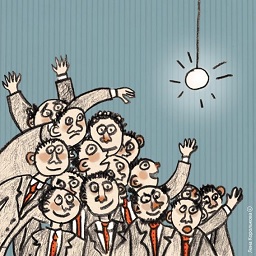 Hello, Habr! Every day we discuss hundreds of relevant topics, such as: GTD , project management , staff motivation , teamwork and other management topics. There is always someone to ask and what to read: a lot of articles, a mountain of textbooks, literature and other things. In the end, man: “ You get paid! ". Accordingly, a completely different topic that has become very relevant at the time of IT development is the motivation of people who get nothing for their work, or, as it is now fashionable to say, crowdsourcing . We’ll talk about this further ...
Hello, Habr! Every day we discuss hundreds of relevant topics, such as: GTD , project management , staff motivation , teamwork and other management topics. There is always someone to ask and what to read: a lot of articles, a mountain of textbooks, literature and other things. In the end, man: “ You get paid! ". Accordingly, a completely different topic that has become very relevant at the time of IT development is the motivation of people who get nothing for their work, or, as it is now fashionable to say, crowdsourcing . We’ll talk about this further ...The causative agents and pathogens
Encouraging people to do better and more efficient work, and so on, is a problem, not to mention a situation where they are not paid a penny for it. In this world, material buns turn into intangible ones, now they have learned to do two things: to motivate right now and in the future (for the future).
With the first situation (motivation now) everything is simple - let's say your father tells you today (5 year old child) that if you behave quietly and go to bed early, tomorrow he will bring you a toy. With the second (in the future), it’s a little more complicated, although it’s the same, only in this case, the father (tomorrow) brings home a new toy, and nails it with a nail to the ceiling, and the child rushes around, realizing that he will get it only when he grows half a meter , about 5 years later, because, the father says - you will grow up and get a toy.
Today there is a very fashionable word "startup", but believe me, when I was creating the project, I could not even suspect that it could be called that. It was all quite simple - there were two guys who were burning with an idea that could make people a little happier during dull everyday life (hereinafter, we are talking about a computer game, a network shooting game).
I believe that the principles described do not depend on the type of game, and the ideological content of the principles will not change when the game changes.
We were ready to invest in this exclusively in a time-cost basis. For myself, everything was clear and laid out on the shelves. When you realize your idea, your project, you don’t need motivation, you already have it. This is an internal motivation (see Figure 1) created by the content of the activity, project, idea, etc.

Figure 1. Intrinsic motivation, example: daily exercise
We are still not gods, and we need a team to create something worthwhile, sometimes a very large team. The team will give the project life. It’s the same as trying to grow a 100 hectare garden alone. Yes, of course, you can first spend several years on automation, build communications, equip everything with the latest technology, create robots, etc., and then sit on the veranda with an iPad and control the process of fertilizing, watering, planting cuttings, treatment and everything else. But let's go back to the earth, we need to start here and now, otherwise tomorrow someone else will do it instead of you ...
Another Samaritan ...
Vasya and Petya simultaneously began to write the same product.
Vasya was “result-oriented” and immediately began to write govnokod without really thinking over the architecture.
And Petya developed the architecture for a month, made a convenient intuitive interface for a month that Joni Ive would envy, then wrote tests for a month, then wrote the code for two months and got an ideal stable application.
But after a month Vasya released the first version of the program, albeit not perfect, albeit with bugs, but working, and began to sell it. A month later, he released the second version, fixing the first bugs and adding new bugs. A month later, he hired two sensible programmers for sales revenue, who in two months shoveled the entire code, according to the wishes of the users, they added the interface and released the third version of the program.
In total, after five months, Vasya had two employees, a bunch of customers and a reasonably working application that meets the wishes of customers.
Petya had an unknown application licked by no one, minus a bank account and not a single client.
At the end of this fictitious example, we can say that after six months Vasya bought all the work of Petya, he hired Petya as a tester, and he crashed drunk on his new Tuareg
(c) http://bash.im/quote/420672
Of course! To care for the garden, we can recruit a dozen good Samaritans. But it’s impossible to pay these people (they are the most merciful and disinterested), but somehow it is necessary to motivate (see Figure 2).

Figure 2. The unmotivated Samaritan
Unified in choosing a useful pastime, we were united by one thing - the desire to relax at our favorite game. Games can be different, and the key feature in this case was that the game should
Step One: Hierarchy and Ranks
At first, friends always come to the rescue (" Yeah! Well, how could they be without them?" ). However, the portal was rapidly gaining popularity, the number of servers was increasing, therefore, attendance was growing, and the number of “anti-guardians” of the rules of the game was also growing. The presence of such players suppresses the desire to play the rest - as a result, after a few minutes the server is empty, karma is lowered, the bottom line of the rating. Sadness.
It’s the same thing that the guys gathered in the yard to play “shooters” with toy pistols, and then Vasya came with the “air gun”, and a few minutes later the guys ran away. Vasya was left alone, out of sadness went to shootchickens on de_italypigeons.
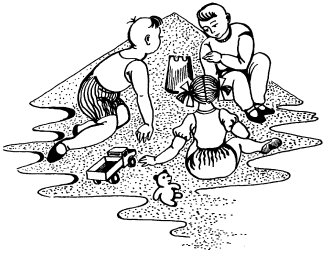
Figure 3. View of the correct game.
Having seen this matter, we ran to hang up recruitment announcements in the group of administrators.
Grading
Grading (Eng. Grading) - Grading - a grouping of posts on certain grounds (definition of "weight", classification) in order to build a motivation system. The essence of grading is in comparing the internal importance of positions for an organization (internal value) with the value of this work on the market (external value).
To say is to do, the staircase (see Figure 4) was agreed upon by the “Council of Elders”, and is presented below:
- Advanced Players
a. ISP - Full-fledged administrators
b. ADMIN
c. PRO ADMIN - Experienced administrators
d. ELITE ADMIN
e. CURATOR - Leaders
f. ROOT
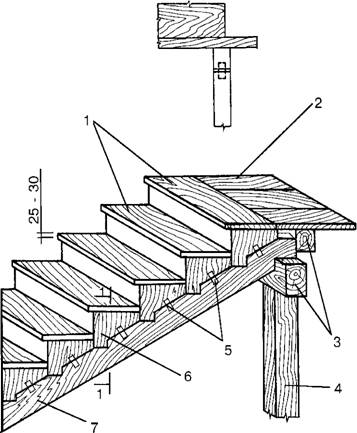
Figure 4. Well-designed career ladder.
For each of the levels, their rights, bonuses and buns were determined, which we would like to strive up the stairs. Undoubtedly, in order for the hierarchy to work, a set of rules is needed, which administrators are guided in their work, as well as punished and promoted. The rules should be the same for everyone, any deviation from the rules can bring "riot on the ship" (" Master, do not rock the boat, but!"), therefore, the leaders firmly fixed them and later they were always guided by the rules (with reference to paragraph). The rules must also be written with a balance of their volume, and the subsequent freedom of action when checking, you should never forget the items in the style: “The manager is always right”, “If this issue is not reflected in the rules, the manager chooses the punishment”. Additionally, I note that since the leader was not alone: the decision was always taken jointly, under a single agreement and decision.
The emergence of a hierarchy provided, on the one hand, “protection” for grandfathers, and privileges earned by experience. At the time of introducing the rules with ranks, the current composition of the administrators was distributed according to the merits. Each new Samaritan now came to the lower rank and he now needed to go a long way and prove that he was worthy of the corresponding, higher, regalia. A great topic is to build a staircase, and people themselves will climb it according to their strengths and ambitions.
The creation of such a hierarchy made it possible to motivate people involved on altruistic principles to actively, responsibly and with their own desire to invest their time in work. It turns out that the external motivation created is independent of human circumstances, based on extensive motives that stimulate the factors of the activity. These may be motives: duty and responsibility, self-determination, obtaining a higher status, avoiding punishment, approval of other people.
Here it is necessary to understand that, for example, passing a trial period required
The creation of this scheme provided not only the motivation and development of the skills of administrators, but also the constant influx of new Samaritans, mentoring and, accordingly, the development of the portal. For 1 year, we have grown from 3 to 9 North 24 to 7 and
Step Two: Increasing Responsibility and Feedback Form
Responsibility for their work is a difficult thing, especially in such a team. Despite the grading motivation, control of the elders, it is not always possible to objectively verify the legitimacy of the actions of administrators. Perhaps the player was kicked out (banned) from the server due to personal hostility, or the administrator’s inexperience ... We did not know how to be here at first (see Figure 5).
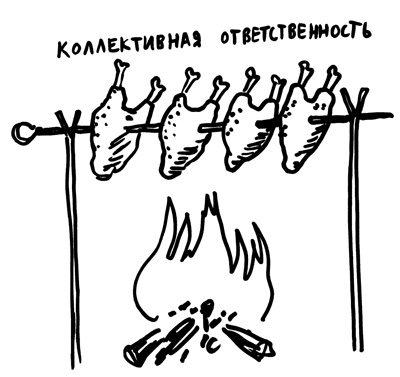
Figure 5. Samaritans loved to fry a couple of chicken for dinner
Sitting once over a cup of tea on the veranda and watching the growing garden and the good Samaritans, we realized that an indicator of the quality of work is the overall growth and development of the garden. But for some reason, some of the trees still die and new ones have to be planted in their place. Having finished tea, we decided to go down to the garden and ask the wise ash tree what to do. For us, quite unexpectedly, despite the absence of this plot in the songs, ash answered us ...
In the feedback form, on the forum. As you already understood, a special section was created for this, where any person could leave a complaint. All complaints were reviewed by management, with decisions taken in accordance with the code of practice.
Step Three: Who is the best here?
And so, a year has passed since the Samaritans began to care for your garden. Rewarding the best, giving them all sorts of labels, "badges" and all kinds of game bonuses is not the same, and it is completely pleasing, as for the first time. Some from boredom leave in their place new ones come, but about the same situation happens to them. Growth to the level of one’s incompetence (see Peter Principle ), stagnation, withdrawal.
Principle of Peter
The principle of Peter is a position put forward and substantiated in the book of the same name by Lawrence Peter. Formulation: “In a hierarchical system, any employee rises to the level of his incompetence.” According to some critics, Peter’s principle should be taken as a joke, although Peter himself stated it without any hint of humor, as a very serious theory

Figure 6. Samaritan for boring free work
Intangible motivation based on grades squeezed all his juices out and works idle with the main backbone of the “vigilantes”. It is difficult to use methods of material motivation, everything falls into variable costs: for iron, the Internet and all that jazz.
The second difficulty that arose, with an increase in the number of servers, administrators' favorite and not favorite game zones began to be clearly visible. First, they solved the problem “head on”: new administrators were recruited only to unpopular servers, and the ability to administer all servers appeared only on the third grade. It was a crutch that reduced motivation, because few people wanted to administer an uninteresting game server. The turnover on such playgrounds was even higher. The ideal situation was when a person comes to the server that he likes (and at the same time he is not popular), such administrators received fast career growth, due to the lack of competition.
It is difficult to say at what point the next idea was born, but technically it could be implemented much earlier. Once, just a glance fell on the statistics of the players, which was developed in one of the first months of the server’s launch. The rating of all players with statistics was displayed: the ratio of kills / deaths, the accuracy of shots, etc. The top 10 flaunting sheet beckoned to itself in the hope of finding itself there, and was extremely popular - it was a motivation for the players ... Stop! And where is the same system for administrators? Here it is - the gold mine of competition: rating!
I remember in elementary school we had this too. The teacher hung the children’s rating by reading speed by ear, seeing this list for the first time, a month later I was in the top 5, and later I constantly fought for the podium with the rest of the wise men.
Comparing yourself to another is nothing better for motivating ambitious people. Is it not true that finding your name in the first line is the satisfaction of the work done, and getting into second place is the desire to work and become the first. Now everything fell into place - all that’s left is small, come up with a calculation methodology and present it to administrators.

Figure 7. Samaritans decide who takes the first line in the ranking
For a long time they did not think, as for the players, the administrators were planned to evaluate on the basis of their actions. As I said, there were no barriers to its solution, because Over the past year, I developed a back-end server administration system, where there were server management entities (their configuration), as well as administrators (rights management, promotion, vacation management), etc. How this system worked is a conversation for a separate topic (if there are requests, I’m ready to tell). One of the functions of this system was to read in the logs all the actions of administrators on all servers. Unambiguously, we could determine what and when the administrator did and on which server ...
The model was used one of the simplest and most popular in the rating: a balanced assessment.
Digression, for fans mathematics weighted score is calculated as follows:,
where- the weighting factor for each of the actions
committed by the administrator;
- A specific administrator’s action score at a specific point and time.
Next, points (weighting factors) were invented for each action (hereinafter, we will say, the action score) and various bonus factors. For example, the coefficient for the administration time: during the unpopular administration time (at night), the action score increased by 25%. Later, various bonuses were added: for the popularity of the administration server, for the current administrator rank, for completing the trial period and returning from vacation, for the high rating, permanent bans, etc. Also, restrictive conditions were introduced in the form of a limited bonus coefficient, the lack of a rating of chief administrators, and a reference rating of “Autobot”.
And so, back to the "materiel". Due to the above changes, the formula is similar to has changed, and now it should reflect all of the features:,
where- coefficient of bonus points for time and place of the act
with a certain score;
- total number of actions committed by administrators;
- the total bonus point, which does not depend on the time and place of the completed action, for example, a bonus for a rank; subject to restrictions on
.
The rating was counted every day and updated on a web page with statistics. Somewhere around one in the morning, the Samaritans fled to find the top 5, then gathered around the fire and discussed the past day. We displayed statistics for the day, week, and month. Now each administrator, according to the results of the day, saw his position and his score. This created an excellent competitive environment, as well as the possibility of an additional assessment to increase administrators in rank. In addition, the promotion of administrators has become more transparent, because now it was obvious to everyone why the rating leaders were being upgraded. And for administrators, there was an opportunity to achieve an increase due to a good rating, which was ensured by the presence of the administrator on the server and its actions.
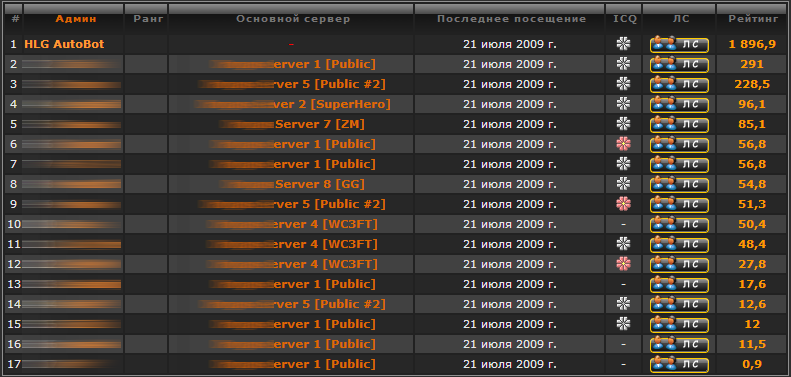
Figure 8. Example daily rating
TOP 15 monthly rating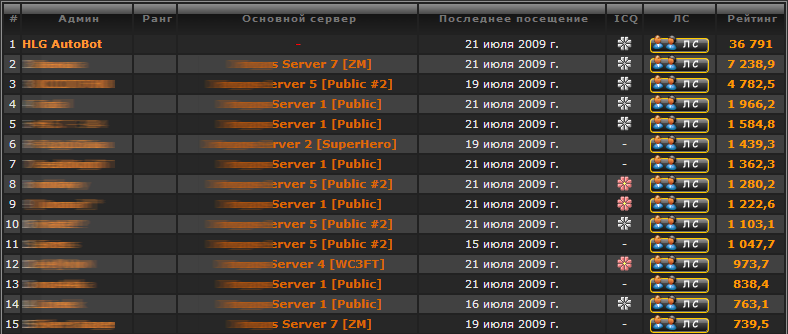
Figure 9. TOP-15 monthly rating

Figure 9. TOP-15 monthly rating
Of course, we understand that any rating has its own shortcomings, therefore it can be “hacked” by the method of testing, this requires adjusting the coefficients every quarter so that the Samaritans cannot get used to it. In addition, the increase should always be made up of both objective facts (rating) and the subjective opinions of portal leaders, player reviews, etc.
Which is returning
Rise, fall, left step, break, rise and fall again - these are ordinary situations and difficulties that we encounter in life. Samaritans, as well as everyone else, dream of promising and interesting work. If every day a new "challenge" does not fall on them from heaven and does not light up their path, they will also leave you, swear daily, demand something else. And you, going out onto the veranda in the morning, to understand that today 5 people didn’t go to the “work” again, go print new ads and hang up at taverns in neighboring villages ...
People leave, people come - every day we invest in their development, and we want to see in them ourselves, the same smart, bold and ambitious. But most importantly, in one moment to understand what is good for you, will never be good for them. And believe me, even if you know the depth of their thoughts and desires (which is impossible in principle) - you still will not achieve the desired result. There is only one way out of this situation - reduce the costs of rotation in the team as much as possible, new employees should receive not only a combat set of management documentation, but also a mentor from the elders who will engage and teach, thereby motivating themselves and the new Samaritan (both internal and external motivation ) (see Figure 10).
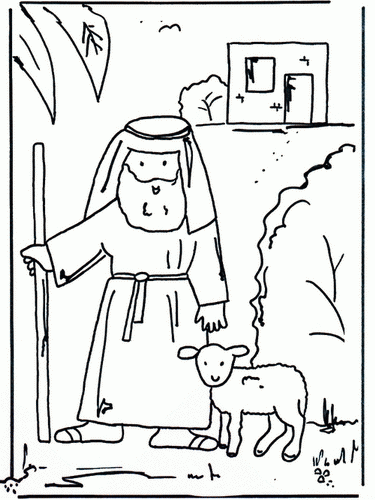
Figure 10. Experienced and young Samaritans
PS: If it is more convenient for someone to read in PDF, then the file is here .
